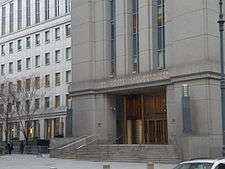Foley Square
Coordinates: 40°42′53″N 74°00′10″W / 40.7147°N 74.0028°W
Foley Square is a street intersection and green space in the Civic Center neighborhood of Lower Manhattan, New York City and – by extension – the surrounding area, which is dominated by civic buildings. The space is bordered by Worth Street, Centre Street and Lafayette Street and lies between City Hall and Canal Street, near Manhattan's Chinatown and east of TriBeCa. It was named after a prominent Tammany Hall district leader and local saloon owner, Thomas F. "Big Tom" Foley (1852–1925).[1]
History and description
Foley Square sits on the site of Collect Pond, which was one of the original fresh water sources for the city, but in 1811 was drained and filled in because it had become severely polluted and implicated in typhus and cholera outbreaks. The neighborhood around the pond was the notorious Five Points neighborhood, home of many gangs.
The square is the site of a number of civic buildings including the classic facades and colonnaded entrances of the 1933-built United States Courthouse, fronted by the sculpture Triumph of the Human Spirit by the noted artist Lorenzo Pace; the New York County Courthouse; the Church of St. Andrew; the Thurgood Marshall United States Courthouse – known before 2003 as the Foley Square Courthouse – where the United States Court of Appeals for the Second Circuit is based; the New York County Municipal Building; the Foley Square Federal Building and the Jacob K. Javits Federal Building and Court of International Trade.[2]
Also featured in the square are five bronze historical medallions, set flush into areas of the surrounding sidewalks, telling the history of the park and its surroundings, including one for the "Negro Burial Ground", an 18th-century African-American burial ground unearthed during construction of the square.[3] This burial ground has been preserved as the African Burial Ground National Monument. In 2005, Tom Paine Park was established as a part of the square.[4]
Foley Square has been used several times for special purposes. It was used as a triage center on September 11, 2001. The Foley Square Greenmarket operates year round at the corner of Centre Street between Worth and Pearl Streets, and offers baked goods as well as local farm picked fruits and vegetables which are guaranteed to have been harvested within three days of sale. Because of its proximity to Chinatown, Foley Square is often host to a large group of people performing tai chi in the mornings.
On November 17, 2011, Foley Square was the site of a protest which was part of the Occupy Wall Street movement, which took place after the protestors had been removed from nearby Zuccotti Park. Thousands of people attended the rally, including members of a dozen different unions.[5]
In popular culture
Film
- In the film of The Godfather (1972), but not in the original 1969 novel, the Corleone Family enforcer, Al Neri, assassinates Don Emilio Barzini on the steps of a building in Foley Square.
- One scene of the film Spider-Man 3 (2007) was shot in Foley Square.
Television
- Foley Square was the name of a television series starring Margaret Colin, which aired on the American television broadcast network CBS from December 1985 to April 1986.
- Foley Square is often seen on the television series Law & Order and its spinoffs.
Gallery
-

New York County Supreme Court at 60 Centre Street
-

Thurgood Marshall United States Courthouse at 40 Centre Street
-

Daniel Patrick Moynihan United States Courthouse at 500 Pearl Street
See also
References
- Notes
- ↑ Moscow, Henry. The Street Book: An Encyclopedia of Manhattan's Street Names and Their Origins. New York: Hagstrom, 1978. ISBN 0823212750, pp.50-51
- ↑ Jackson, Kenneth T., ed. (1995). The Encyclopedia of New York City. New Haven: Yale University Press. ISBN 0300055366., p.421.
- ↑ http://www.nycgovparks.org/sub_things_to_do/attractions/public_art/monuments/african_american_experience/html/image_8.html
- ↑ "Tom Paine Park" at the New York City Department of Parks and Recreation website
- ↑ Buckley, Carla. "200 Are Arrested As Protesters Clash With the Police". The New York Times (November 17, 2011)
External links
| Wikimedia Commons has media related to Foley Square. |
| ||||||||||||||||||||||||||||||||||||||||||||||||||||||||||||||||||